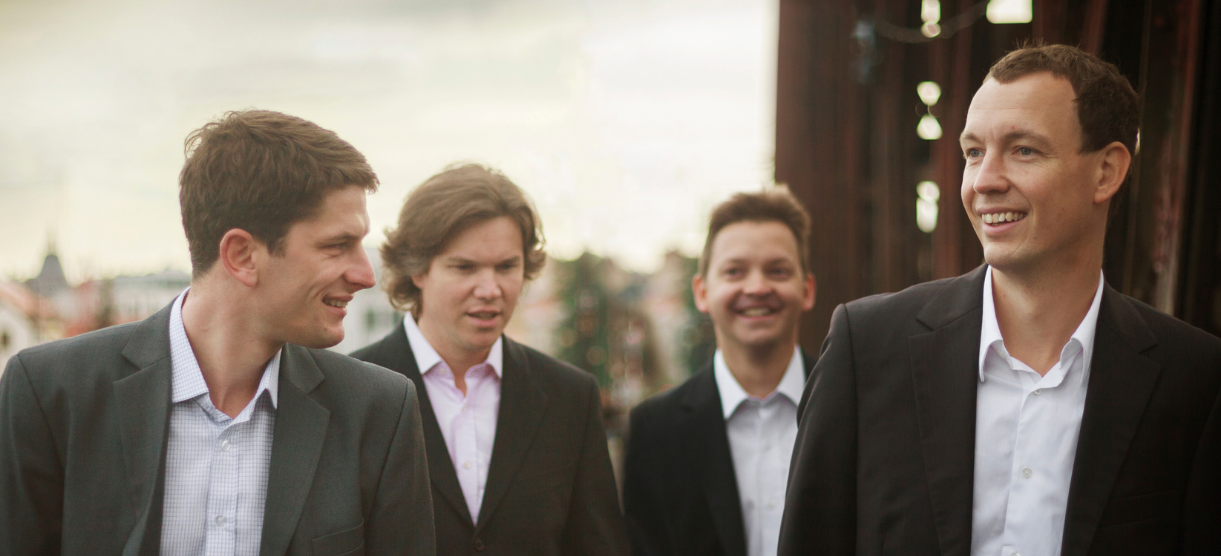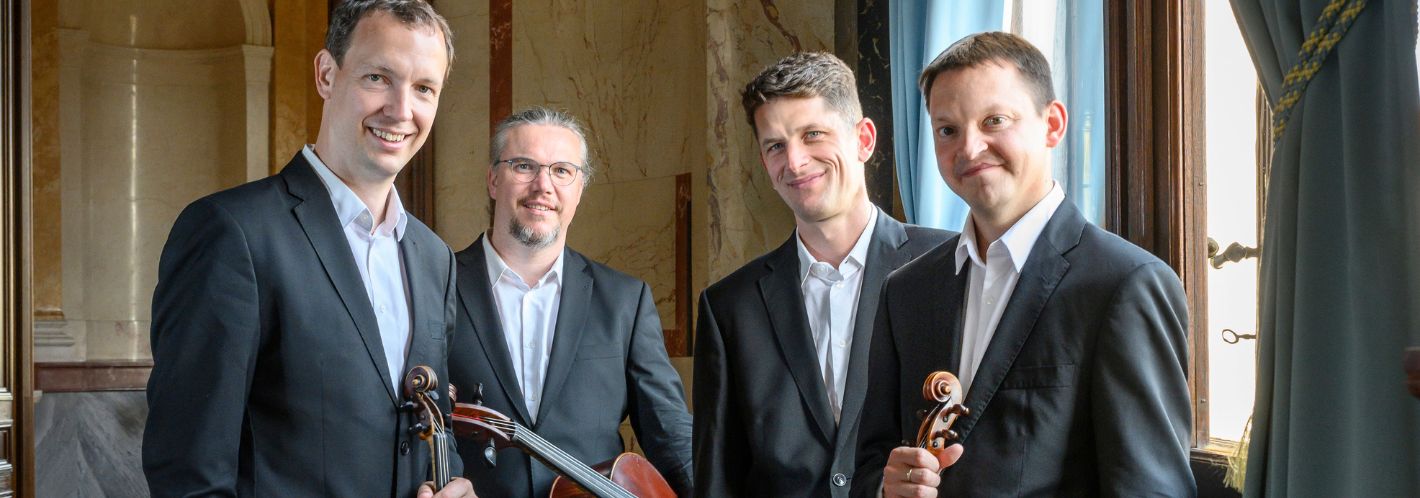
Joseph Haydn: String Quartet in E flat Major, Op. 33, No. 2 "The Joke"
Antonín Dvořák: String Quartet No. 4 in E Minor, B. 19
String Quartet No. 4 in E Minor, B. 19: String Quartet No. 2 in A Minor, Op. 13
This might have been an evening of great classics if Dvořák at age 29 had not launched into experiments with period trends. From the first movement, his String Quartet No. 4 in E Minor is filled with emotionally passionate music that seems to follow in detail the composer’s excited state of mind and to be an outgrowth of the music of his Neo-Romantic predecessors like Hector Berlioz and Franz Liszt. “Oh well, young people”, the water goblin from the opera Rusalka might sigh, just as he did about the frolicking wood sprites. Of course, Dvořák’s Fourth Quartet is not juvenilia. Above all, it shows that Dvořák was already able to handle musical material superbly, and that gave him the freedom to seek and define his own personal style. The manuscript was discovered in the estate of Antonín Bennewitz, and thanks to the Dvořák Collection, the Chamber Series, and the performance by the Bennewitz Quartet, the work shall again be connected with the name of the violinist and director of the Prague Conservatory.
In Dvořák’s music, the classical foundations usually shine through, and we are reminded of those foundations in their pure form by the String Quartet in E-flat Major by Joseph Haydn – its comical conclusion is one of the proofs that humour exists in music. Felix Mendelssohn-Bartholdy then contributes a truly youthful yet stylish work. He wrote his String Quartet No. 2 in A Minor at 18 years of age.
The Bennewitz Quartet is one of the leading international chamber ensembles, a status confirmed not only by their victories in two prestigious competitions—Osaka in 2005 and Prémio Paolo Borciani in Italy in 2008—but also by critical acclaim. As early as 2006, the German Frankfurter Allgemeine Zeitung wrote: “… the music was remarkable not just for its clarity of structure, but for the beautiful tonal palette and purity of intonation in its execution. Only very rarely does one experience such skillfully crafted and powerful harmonies... Great art.” The ensemble has received various awards on the Czech music scene as well. In 2004, the quartet was awarded the Prize of the Czech Chamber Music Society, and in 2019, the four musicians won the Classic Prague Award for the Best Chamber Music Performance of the Year.
The quartet regularly performs at major venues both in the Czech Republic and abroad, including Wigmore Hall in London, Musikverein in Vienna, Konzerthaus in Berlin, Théâtre des Champs-Élysées in Paris, The Frick Collection in New York, Seoul Arts Center, and the Rudolfinum in Prague. They are frequent guests at renowned festivals such as the Salzburger Festspiele, Lucerne Festival, Rheingau Musik Festival, Kammermusikfest Lockenhaus, and the Prague Spring. The group has had the privilege of working with outstanding artists such as Jean-Yves Thibaudet, Alexander Melnikov, Vadim Gluzman, Isabel Charisius, Pietro de Maria, Reto Bieri, Danjulo Ishizaka, and others.
The Bennewitz Quartet takes particular pleasure in performing on the Czech music scene. A highlight of their career was their collaboration with the Czech Philharmonic and conductor Jiří Bělohlávek in a performance of Bohuslav Martinů’s Concerto for String Quartet and Orchestra. The group also recorded both quartets by Leoš Janáček for Czech Television in the unique setting of Villa Tugendhat in Brno. Czech Radio regularly records the quartet’s major concerts.
The members of the quartet place great emphasis on an inspiring and sometimes challenging choice of repertoire. In 2012 and 2015, they performed all six of Bartók’s string quartets in a single evening at Maggio Musicale Fiorentino and in Uppsala, Sweden. In 2014, they premiered The Songs of Immigrants by Slavomír Hořínka at Konzerthaus Berlin. In 2019, they added a new album to their discography featuring the works of persecuted Jewish composers—Hans Krása, Viktor Ullmann, Erwin Schulhoff, and Pavel Haas—released under the Supraphon label.
In the 2024/25 season, the Bennewitz Quartet will return to several European venues, including Wigmore Hall in London, Laeiszhalle in Hamburg, and Konzerthaus Berlin, performing the string quintets of Dvořák and Brahms with Veronika Hagen. They will also tour the United States, making their debut in Providence, Houston, and Tucson, while returning to the Music and Beyond Festival in Ottawa and The Harvard Musical Association in Boston. Meanwhile, various concert projects will continue in the Czech Republic. The final concerts of their complete cycle of Dvořák’s string quartets will take place in September as part of the Dvořák Prague Festival. Later that month, a new CD featuring string quartets by composers who “used to play together”—Haydn, Mozart, Vaňhal, and Dittersdorf—will be released under the Supraphon label.
Since 1998, the quartet has borne the name of violinist and director of the Prague Conservatory, Antonín Bennewitz (1833–1926), who played a crucial role in establishing the Czech violin school. Among his most significant students were Otakar Ševčík and František Ondříček, as well as Karel Hoffmann, Josef Suk, and Oskar Nedbal, who—under Bennewitz’s influence—formed the famous Bohemian Quartet.
source: Bennewitz Quartet

At the present location of the Church of Sts Simon and Jude and of the Nemocnice Na Františku (St Francis Hospital), Bohuslav of Olbramovice established an infirmary before 1354, an essential part of which was the Chapel of St Simon and St Jude, preachers of the Gospel in Mesopotamia and Syria, which was consecrated by Arnošt of Pardubice (Ernst von Pardubitz), the Archbishop of Prague, who worked closely with Emperor Charles IV. The chapel was gradually renovated and expanded, and the changes made to it by non-Catholic churches shortly before 1620 were so grandiose and pioneering that the site had the ambition of becoming a serious ideological and architectural competitor with the St Vitus Cathedral. Thereafter, further renovations and additions continued for a long time, the interior was lavishly decorated, an altar was built, sculptures were installed, and the crowning glory was an altar painting in the presbytery completed in 1773 by Josef Hager. Between 1989 and 1993, the City of Prague supported extensive renovations converting the church into a concert hall, and the building was handed over to the administration of the Prague Symphony Orchestra. In 2020 the City of Prague bought the building, and in 2021 it was entrusted to the Prague Symphony Orchestra, which uses the venue as a hall for its subscription chamber music concerts.
The original church was part of the Na Františku Hospital and Monastery of the Brothers of Mercy. In the 18th century it was renovated in the High Baroque style, and an organ was installed there, which was later by such masters as W. A. Mozart and Joseph Haydn. That organ is still in use today.